Cisco Wireless Mesh Access Points, Design and Deployment Guide, Release 8.6
Bias-Free Language
The documentation set for this product strives to use bias-free language. For the purposes of this documentation set, bias-free is defined as language that does not imply discrimination based on age, disability, gender, racial identity, ethnic identity, sexual orientation, socioeconomic status, and intersectionality. Exceptions may be present in the documentation due to language that is hardcoded in the user interfaces of the product software, language used based on RFP documentation, or language that is used by a referenced third-party product. Learn more about how Cisco is using Inclusive Language.
- Updated:
- December 22, 2017
Chapter: Air Time Fairness in Mesh Deployments rel 8.4
Air Time Fairness
in Mesh Deployments rel 8.4
Air Time Fairness in Mesh Deployments Rel 8.4
This section of the document introduces the ATF on Mesh APs and provides guidelines for its deployment. The purpose of this section is to:
Pre-requisite and Supported Features in 8.4 release
Mesh ATF is supported on AireOS 8.4 or higher release on a Wireless LAN Controller . Mesh ATF is supported on 1550/128, 1570 and all other IOS based APs.
| AP | 1550 (64 MB) | 1550 (128 MB) | 1570 | 3700 | 1530 | 1540 | 1560 |
|---|---|---|---|---|---|---|---|
| Feature | – | – | –– | – | – | – | – |
| Basic Mesh | Yes | Yes | Yes | Yes | Yes | Yes | 8.4 |
| Flex+Mesh | Yes | Yes | Yes | Yes | Yes | No | No |
| Fast Convergence (background scanning) | No | 8.3 | 8.3 | Yes | 8.3 | No | 8.4 |
| Wired Clients on RAP | Yes | Yes | Yes | No | Yes | No | No |
| Wired Clients on MAP | Yes | Yes | Yes | No | Yes | No | 8.4 |
| Daisy Chain | 7.6 | 7.6 | 7.6 | No | 7.6 | No | No |
| LSC | Yes | Yes | Yes | Yes | Yes | No | No |
| PSK provisioning: MAP-RAP authentication | 8.2 | 8.2 | 8.2 | 8.2 | 8.2 | 8.5 | 8.4 |
| ATF on Mesh | No | 8.4 | 8.4 | 8.4 | No | No | No |
Cisco Air Time Fairness (ATF) Use Cases
Public Hotspots (Stadium/Airport/Convention Center/Other)
In this instance a public network is sharing a WLAN between two (or more) service providers and the venue. Subscribers to each service provider can be grouped and each group can be allocated a certain percentage of airtime.
Education
In this instance, a university is sharing a WLAN between students, faculty, and guests. The guest network can be further partitioned by service provider. Each group can be assigned a certain percentage of airtime.
Enterprise or Hospitality or Retail
In this instance, the venue is sharing a WLAN between employees and guests. The guest network can be further partitioned by service provider. The guests could be sub-grouped by tier of service type with each subgroup being assigned a certain percentage of airtime, for example a paid group is entitled to more airtime than the free group.
Time Shared Managed Hotspot
In this instance, the business entity managing the hotspot, such as a service provider or an enterprise, can allocate and subsequently lease airtime to other business entities.
ATF Functionality and Capabilities
ATF Functionality and Capabilities:
- ATF policies are applied only in the downlink direction (AP transmitting frames to client). Only airtime in the downlink direction, that is AP to client, can be controlled accurately by the AP. Although airtime in the uplink direction, that is client to AP, can be measured, it cannot be strictly controlled. Although the AP can constrain airtime for packets that it sends to clients, the AP can only measure airtime for packets that it 'hears' from clients because it cannot strictly limit their airtime
- ATF policies are applied only on wireless data frames; management and control frames gets ignored
- When ATF is configured per-SSID, each SSID is granted airtime according to the configured policy
- ATF can be configured to either drop or defer frames that exceed their airtime policies. If the frame is deferred, it will be buffered and transmit at some point in the future when the offending SSID has a sufficient airtime budget. Of course, there is a limit as to how many frames can be buffered. If this limit is crossed, frames will be dropped regardless
- ATF can be globally enabled or disabled
- ATF can be enabled or disabled on an individual access point, AP group or entire network
-
Allocation is applied Per SSID and Per Client
-
Applies to Downstream only
-
Can be configured in WLC GUI/CLI and PI
-
Can be applied to all APs on a Network to AP Group or one AP
-
Supported on APs in Local mode: AP1260, 1550-128Mb,1570, 1700, 2600, 2700, 3500, 3600, 3700
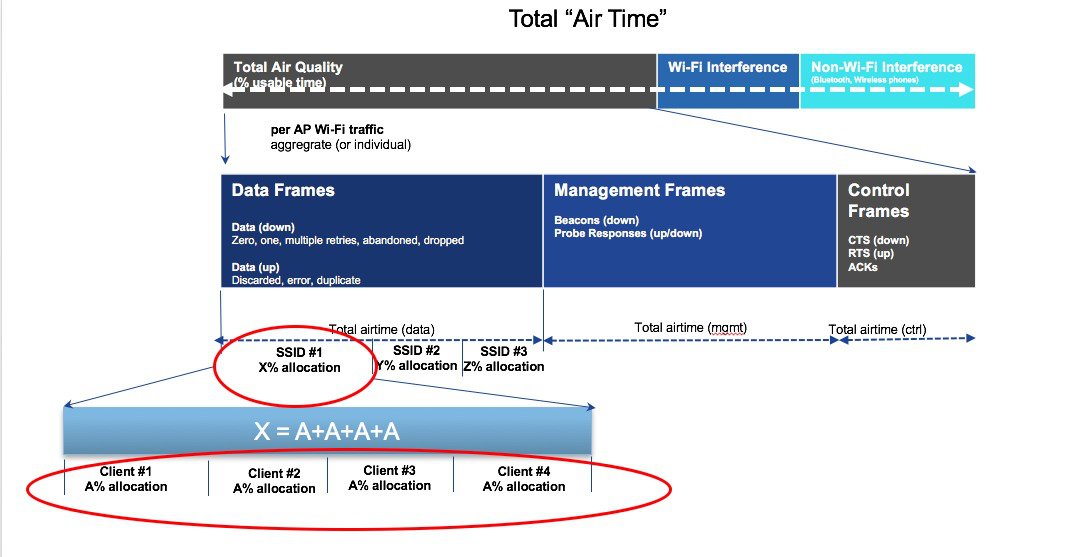
ATF on Mesh Feature Overview
AirTime Fairness on Mesh Aps feature is very close conceptually to the ATF feature support release for Local Aps in theprevious releases. We are strongly recommend to review that feature and deployment steps in the guide at http://www.cisco.com/c/en/us/td/docs/wireless/technology/mesh/8-2/b_Air_Time_Fairness_Phase1_and_Phase2_Deployment_Guide.html
At the present time, enterprise class, high density stadium and other major Wi-Fi deployments with Cisco IOS 11n, 11ac Indoor APs are benefited by "per SSID" based Airtime Fairness and "per Client within a SSID" based Airtime Fairness through 8.1 MR1 and 8.2 releases.
In a same way, currently, there is a demand from the Customers with large scale Outdoor wireless mesh deployments to serve their users by providing fairness among the Wi-Fi users across the Outdoor wireless mesh network in utilizing the AP radio Airtime downstream and also provide administrators the key control to enforce SLA (implied on multiple cellular operator through Wi-Fi hotspot) on the Wi-Fi users across the Outdoor wireless mesh network. However, since all Wi-Fi users traffic is bridged between MAPs and RAPs through the wireless backhaul radio and there is no SSID concept on wireless backhaul radio for backhaul nodes to enforce policies through SSID's for each backhaul node, there is no easy solution for Wi-Fi users across the Outdoor wireless mesh network to get treated fairly in terms of utilizing the Wi-Fi airtime through their Outdoor Wireless Mesh Aps. As far as the clients on client access radios are concerned, it's fairly simple to regulate the airtime fairness through SSIDs (w/ or w/o client fair sharing) in a similar way how it is done for Cisco unified local mode APs.
Before the solution overview of supporting ATF on mesh, lets quickly recap ATF - Airtime Fairness (ATF) is basically a concept which provides an ability to regulate/enforce the AP radio airtime in downstream direction for the clients associated through the SSID's. As a result, the Wi-Fi users on wireless network are fairly treated in terms of utilizing the radio WiFi radio airtime. This basically provides the key control either to enforce SLA additionally or simply to avoid certain group or individual from occupying an unfair amount of WiFi airtime on a particular or on a given AP radio. A service level agreement (SLA) is a contract between a service provider (either internal or external) and the end user that defines the level of service expected from the service provider. SLAs are output-based in that their purpose is specifically to define what the customer will receive.
In general, in
the Mesh architecture, the Mesh Aps (Parents, child MAPs) in a Mesh Tree will
be accessing the same channel (let's forget about extended sub-backhaul radios
for a minute) on backhaul radio for mesh connectivity between Parents and child
Maps. Whereas, the Root AP will be connected wired to the controller and MAPs
will be connected wireless to the controller. Hence all the CAPWAP, Wi-Fi
traffic will be bridged to the controller through the wireless backhaul radio
and through RAP. In terms of the physical locations, normally the RAPs will be
placed at roof top and the MAPs in multiple hops will be placed some distance
apart within each other based on the Mesh network segmentation guidelines.
Hence each MAP in a Mesh tree can provide 100% of their own radio airtime
downstream to their users though each MAP accessing the same medium. To compare
this in non-mesh scenario, where there can be neighboring local mode unified
Aps in the arena next to each other in different rooms serving to their
respective clients on the same channel with each providing 100% radio airtime
downstream. Therefore, ATF has no control over enforcing clients in two
different neighboring AP's accessing the same medium. Similarly, it's
applicable for MAPs in a Mesh tree. For Outdoor/Indoor Mesh Aps, Airtime
fairness must be supported on client access radios which serve regular clients
as same as how we currently support ATF on non-mesh unified local mode Aps to
serve the clients and additionally it must also be supported on backhaul radios
which bridge the traffic to/from the clients on client access radios to RAPs
(one hop) or through MAPs to RAPs (multiple hops). Its bit tricky to support
ATF on backhaul radio's using the same SSID/Policy/Weight/Client fair sharing
model. Since backhaul radio's doesn't have SSIDs and it always bridges traffic
through their hidden backhaul nodes. Henceforth, on the backhaul radios either
in RAP or MAP, the radio airtime downstream will be fair shared equally based
on the number of backhaul nodes. This approach eliminates the problem and
provides fairness to users across wireless mesh network in the case where the
clients associated to 2nd hop MAP can stall the clients associated to 1st hop MAP where
2nd hop MAP is
connected wireless to 1st hop MAP through backhaul radio though the Wi-Fi users
in the MAPs are separated by a physical location. In the scenario, when a
backhaul radio has an option to serve normal clients through universal client
access feature, ATF considers the regular clients into single node and group
them into it. It enforces the Airtime by equally fair sharing the radio airtime
downstream based on the number of nodes (backhaul nodes + single node for
regular clients). We will see more details how this solution is turned into
design in the next sections.
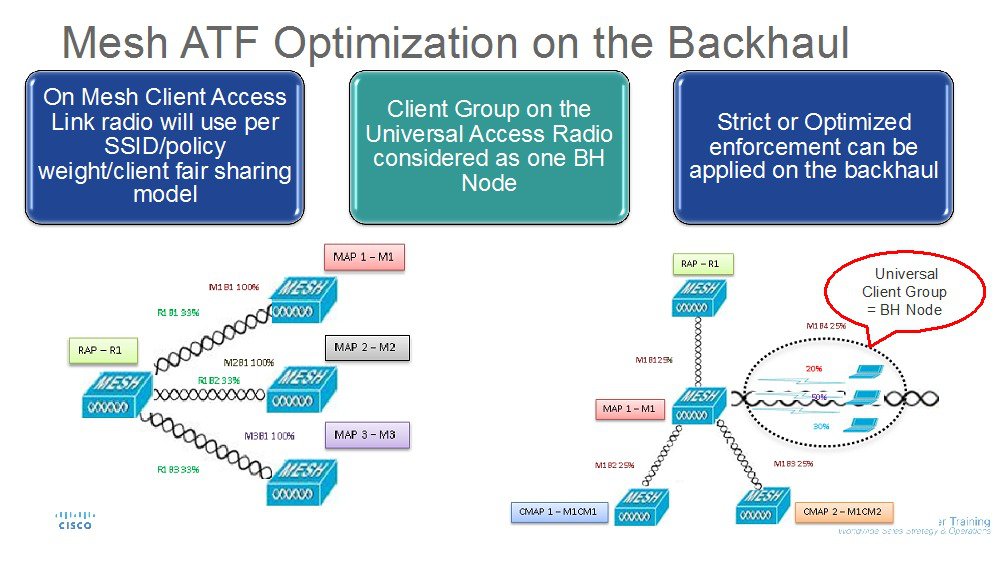
A bigger mesh
design will looks like this:
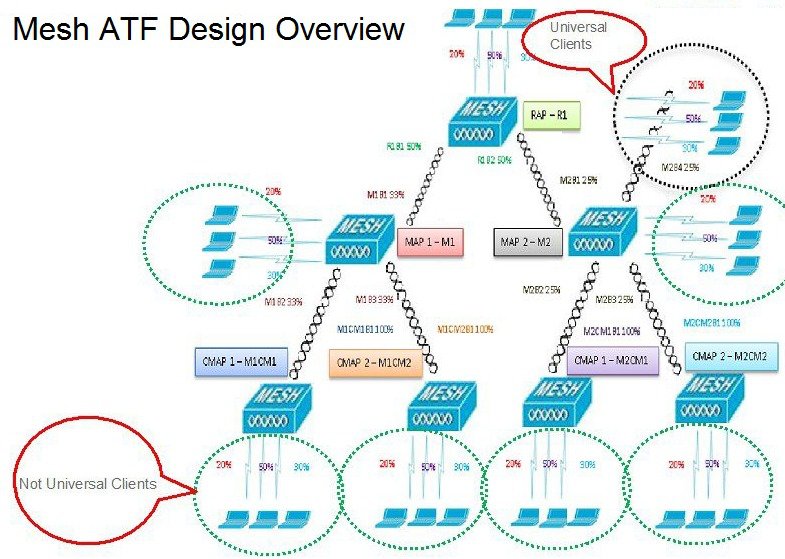
ATF Modes of Operation
The Framework behind the ATF monitor mode is to allow the user to view and get the stats of overall Air Time being used i.e. to report the Air Time usage for all the AP transmissions. The ATF in monitor mode can be enabled on following levels.
Configuring ATF on Mesh
To configure, ATF on mesh, perform the following steps:
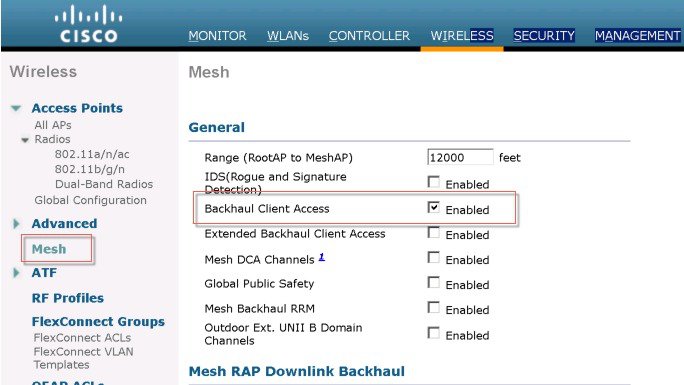
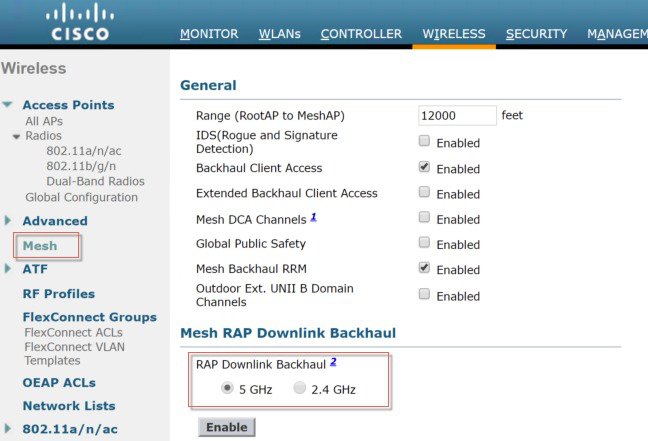

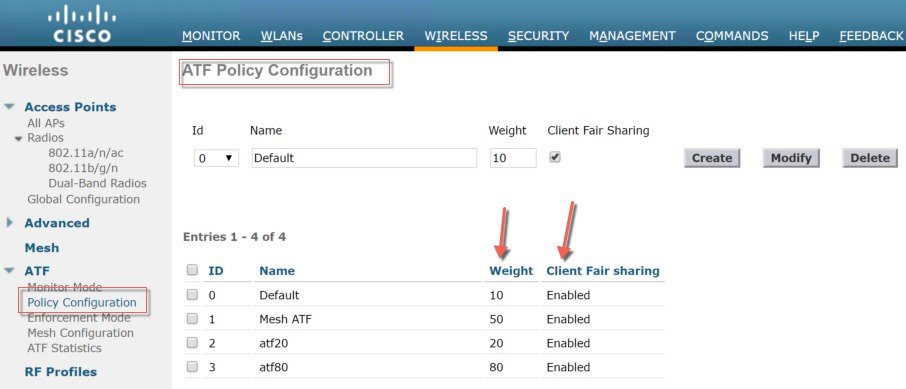
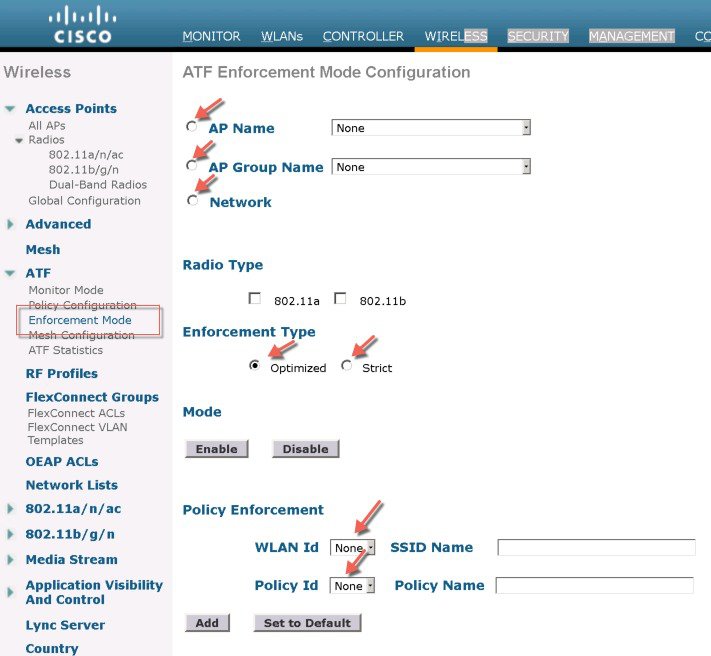
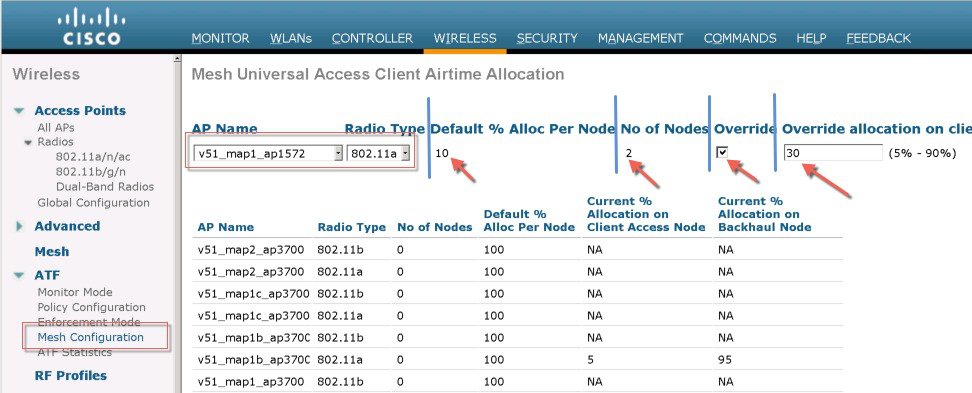
 Feedback
Feedback